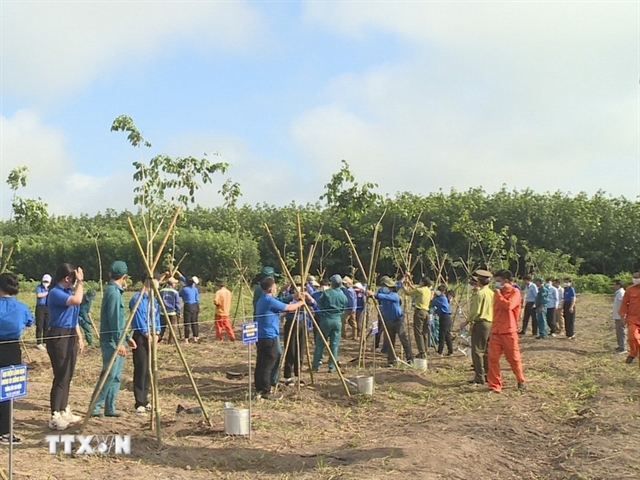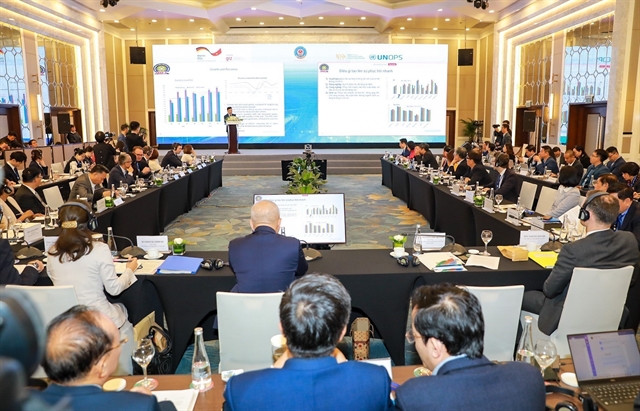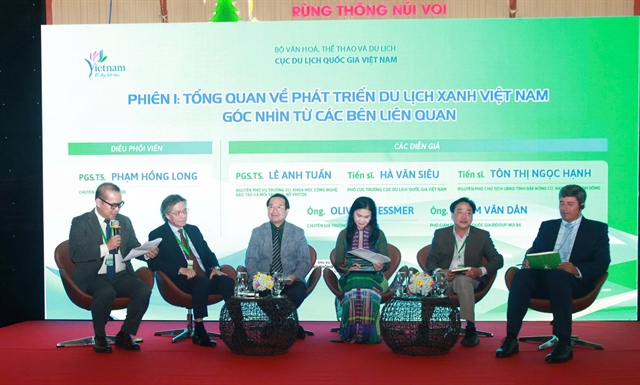 Economy
Economy

 |
| A yarn factory in Bình Chánh District, HCM City. The demand for garment products is improving in the last quarter of this year. — VNA/VNS Photo Hồng Đạt |
HÀ NỘI — There are positive signals for the recovery of garment export in 2024 but cautions remained over ongoing global uncertainties, experts said, urging the industry to accelerate the green transition to take opportunities from the sustainability trend taking shape worldwide.
Exports have slumped from the beginning of this year as soaring inflation and economic recession took their toll on consumption demand in major export markets of Việt Nam. However, the drops slowed down in recent months.
Statistics of the General Department of Customs showed that the export of garments fell by 12.9 per cent to US$27.7 billion in the first ten months of this year, and of textiles by 10.8 per cent to $3.65 billion.
In October, however, textile export rose 4 per cent over September to $389 million and garment saw a drop of only 0.1 per cent.
The difficulty was not unique to the garment and textile industry of Việt Nam but common for the global export due to a decrease in global aggregate demand driven by geopolitical tensions, global economic recession, rising inflation in major markets such as the US and the EU, and tightened monetary policies forcing consumers to cut spending, Dương Thuỳ Linh, deputy general secretary of the Việt Nam Cotton and Spinning Association (VCOSA), said.
Meanwhile, markets’ requirements for sustainability standards were becoming more and more stringent, together with stronger competition from other exporters such as Bangladesh and Myanmar, resulting in fewer and smaller orders.
Linh said that many textile companies were forced to narrow the production scale to 50-80 per cent from the end of last year to the second quarter of this year. However, slight recovery started from July with most producers resuming their full capacity.
VCOSA forecast that challenges would remain for the garment and textile industry of Việt Nam because the low consumption demand would persist in 2024.
The association projected that the export value would be around $40 billion this year, a drop of 10 per cent.
“The worst moment is passing by,” Linh stressed, however, adding that the macroeconomy remains stable with GDP growth projected at 5 per cent, inflation is under control at 3.2 – 3.6 per cent and lending rates are being reduced to support enterprises.
She pointed out that Việt Nam’s garment industry still had the competitive advantage in labour cost. The industry also benefited from new-generation free trade agreements (FTAs) Việt Nam signed with major markets.
The market demand is improving, Phạm Văn Việt, chairman of the Việt Thắng Jean Company, said. “Although the purchasing power has not returned to the previous level, orders are gradually recovering to around 80 per cent for the last quarter of this year,” Việt said.
Push for sustainability
Nguyễn Thị Tuyết Mai, deputy general secretary of the Việt Nam Textile and Apparel Association, said the sustainability trend was taking shape rapidly in the global market with strict requirements on environment protection and labour, requiring enterprises to speed up green transition.
Although local producers still face difficulties in meeting sustainability standards, there were good signals as several fibre producers met international standards such as Global Recycle Standard, Oeko-Tex and BCI, and were switching to using organic cotton, natural fibres and renewable energy in production, Linh said.
Expert Huỳnh Thanh Điền said that recent forecasts were better for global economic growth, providing the base for optimism about the recovery of consumption demand in major markets.
“New trends are emerging in a new economic cycle. For the garment industry, it is the trend for green and sustainable development,” Điền said, urging enterprises to take action to be able to grasp these opportunities.
Major markets such as the EU are strengthening the implementation of high requirements and standards on greening and sustainable development. “There are challenges but also opportunities for enterprises to make breakthrough developments.”
Lê Tiến Trường, chairman of the Việt Nam National Textile and Garment Group, said that the demand would improve overall in 2024 but the improvement would not be very significant.
Trường said that the 2024 demand would still be 5-7 per cent lower than 2022.
He urged enterprises to be prepared for extended producer responsibility (EPR), the EU’s carbon border adjustment mechanism (CBAM) and the Uyghur Forced Labour Prevention Act (UFLPA) which would have significant impacts on exports. — VNS




